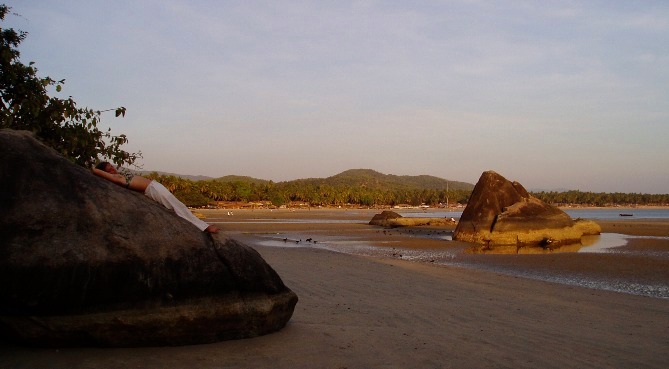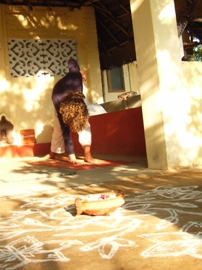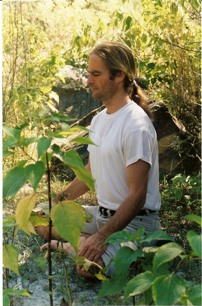
This series of yoga exercises is helpful for meditation. Unlike much of the yoga popular today, these practices are designed to calm our over-stimulated systems. Please do these practices gently.
In the original text on yoga, Patanjali defines yoga posture (asana) as “that posture in which the body can happily be still for a long time.” This joyful stillness then allows the mind, breath, and energy to quiet down, harmonize, and find a way in towards deep meditation and freedom.
Most of the well-known yoga postures were developed centuries after Patanjali to address particular needs in the culture at that time: mainly to stimulate energy in people who were too passive to rouse themselves for meditation. In our current culture, the last thing we need for meditation is more stimulation. These very simple yoga exercises can help cool down our mental chaos and prepare us for going inwards.
These exercises also help us connect to the lower belly and clear, support, and awaken the spine. The spine may sometimes host stuck energy and certainly has the potential to flow helpful energy.
If possible, do these exercises
1) very gently
2) every day
3) in the recommended order
4) in the morning before having any food or drink (except water).
You can add other exercises if you want. If you are new to yoga, or have a delicate or stiff back, you may want to go to a few yoga classes and warm up the back with exercises 13 and 14, before you do exercise 11 (a backward arch).
If you cannot do all the exercises, then we recommend that you at least include the joint rotations, knees to abdomen, and half boat in your practice (exercises 3, 6 and 9).
Benefits may be felt immediately, but it usually takes many months of daily practice to feel the subtle energy of these exercises.
Use a soft, folded blanket, a firm mattress, or a yoga mat with a folded blanket on top.
The full series should take about 20 minutes once you are familiar with it.
Some words of caution: Yoga literally means “union,” and at least we can let body, intention, and mind unite by connecting and listening to the body. Most of the exercises in this series are simple, but please do not strain your body. Approach unfamiliar exercises with gentleness and care. If you are not sure about an exercise, it is best to ask a yoga facilitator or experienced practitioner.
Please enjoy.
Standing asanas:
1. Sweeping. Stand with legs slightly wider than hip-width apart. If you are 35 or older, turn your toes towards each other as far as possible without straining your knees, but so that you nearly lose your balance. If the sweeping takes longer than 5 minutes, then you can move your feet into a more comfortable position after 5 minutes.
If you are younger than 35, just stand in a comfortable position.
Bring your attention to the top of your head and begin sweeping attention down through the body. You can pause and relax anywhere that you notice extra tension. First come down head, neck, shoulders, and upper chest and back, and then down the left arm and then the right arm. Then down the main body, and then the left leg and right leg.
Pay extra attention to the following areas:
-In the head, as you sweep down the head near the eyes, try to feel something like a heavy, horizontal curtain. Gently “shake” or “wave” this curtain with your attention.
~ Under arms.
~ Knees, particularly clearing the tissue between the joint and kneecap.
Initially the sweeping may take longer, but 5 minutes or so is enough after some practice.
2. Squats. Still standing, relax feet so they are only slightly pointing inward. Swinging your arms for help, come down into squatting position and then stand up again.
Repeat 5 times.
3. Joint Rotations. Stand comfortably.
Rotate joints several times in both directions:
~ ankles—one at a time in the air or sitting on the edge of a bed or chair;
~ knees—bring feet and knees together, hands to knees and rotate;
~ hips—bring feet wide apart and hands to hips and make wide circles with the hips;
~ waist and chest—hands still on hips, making circles with the chest and ribcage;
~ shoulders—bring hands to shoulders and breathe out as the elbows touch in front of the face, and breathe in as elbows reach out and back;
~ head and neck—especially gently, and before rotating the head it can help to stretch the neck forward and then back;
~ elbows;
~ wrists.
4. Breathing up. Standing with feet hip width apart, breathe in and raise arms along sides of body and upwards. Breathe out completely, sucking the belly in as the out-breath leaves your body. Allow the in-breath to happen on its own.
Repeat 2 times, keeping arms up through the two cycles.
On the third in-breath reach up, and while holding breath in, direct energy flowing down through the hands and arms into the back. Breathing out, gently release the arms back down to the sides of the body.
5. Half sun salutation and circular push-ups. Stand at the front of your mat or blanket. Breathing in, bring arms up along the sides of the body and above the head. Stretch arms above the head and bring palms together, stretching and looking up. Breathing out, bend forward and stretch hips back.
As you find a good forward bend, let the hands touch the feet or shins. Bring your head to rest for several breaths by your left leg, then by your right, then at the center.
Breathing in and placing both hands on the floor, look up and bring your right foot straight behind you, bending the left knee. The weight of your body is balanced on both feet and both hands. Breathing out, bring your left foot back next to the right foot, pushing from the hands and the feet to create an upside down V shape.
From this position dive your main body down and forward, coming parallel to the ground and then circling back up to the upside-down V. Repeat this last sequence 5 times.
Finish in the upside-down V and stretch the backs of the legs as you press the heels towards the floor.
Then finish with a lunge where the right leg is bent in the front and the left leg is straight back.
You can also simply begin from the upside down V and just do the 5 circular push-ups.
Lying on your back:
6. Knee to abdomen. Lie down on a mattress or soft surface. Flex your feet until your lower back relaxes. Then point toes away from you until you feel the front, upper thighs relax. Then, “with permission” from your body, slowly bend left knee and bring it towards the abdomen and chest. Press the left heel into the inner right leg as the left foot travels up. Feel the whole body respond to each micro-movement. Clasp your hands on top of and below the knee, press your thigh into your abdomen, and raise your head to your knee. Hold for several breaths and release slowly. Repeat with right leg.
Flex and point toes again and repeat knee bend with both legs together.
7. Gently rock into a spinal twist to each side.
8. Roll. As you roll backwards and forwards, notice if the back feels stuck anywhere and massage with the rolling at that point.
9. Half boat. With attention firmly resting in the abdomen, balance on the sitting bones with legs and main body in the air. Beka, a yoga facilitator recommends: to “sit with legs straight out in front and feet together. Make sure you can feel the contact between your sitting bones and the floor. You can help this by taking the buttock flesh out and back with your hands. Bring legs up 60 degrees, and at the same time lean your upper body back 45 degrees. Have your arms straight out, parallel to the floor and with the palms facing each other. You should be balancing on your sit bones and not on the lower spine.”
Hold for 5-20 breaths and release.
10. Bicycle. Lying on your back bring one leg up with bent knee while the other leg extends out away from you, and ‘cycle’ 10-30 times in each direction. If you feel a strain on your back bring your legs closer to your chest.
11. Backbend. Arch the back with hands and feet firmly on the floor. From sangha member Beka: “Lie on your back with your legs bent at the knee and your feet on the floor, hip-width apart. Breathe fully and allow your spine to settle under your hips. Bring your arms over your head so that your hands are just behind your shoulders, the palms facing down and the fingers pointing towards your feet. Your elbows will be pointing upwards.
Press into your hands to push yourself up, first onto the crown of your head. This may be enough if you are new to the pose. You can continue the push into your hands to bring your head off the floor, so that your body makes a full arch. The palms of the hands and the soles of the feet stay in contact with the floor throughout, while the head simply hangs down. If you are unfamiliar with this exercise please be very gentle and careful, allowing your body to learn it over time. Take special care also coming out of the position. It is important to tuck your head in, bringing your chin into your chest, so as to protect your neck.”
12. Shoulder stand and plough. Balancing on the shoulders, support the upper back with the hands and move the main body and legs towards the vertical. Beka: “Lie flat on your back. Slowly raise legs, bending them at the knees and continue raising legs and main body up until your body is straight and supported by your shoulders. Hold for a few seconds. Come down gently, allowing you legs to drop back behind your head. Keep your legs as straight as you can, and let the feet rest first to the left of your head. After a few moments, slowly move your legs to the right of your head. After a few moments, move your legs to the center, behind your head. Rest. Release your legs slowly and roll down to lying on your back.”
Lying on the belly:
13. Cobra. Beka: “Lying on your stomach, bring an intention of softness to your lower spine. Encourage your tailbone to incline downwards without causing tightness. Place your hands on the floor by the middle of your chest with your fingers pointing forwards. Breathe in and press into your hands, allowing your chest to come up, noticing where the arching of the spine begins. Encourage the shoulders to drop and the chest to stay open. The actual bend of the spine comes from the point between the shoulder blades and not from the lower back. Feel the spine uncurl as you come back down.
Repeat one more time.”
14. Wheel. Beka: “You may wish to have more padding under you for this exercise.
Lie flat on your stomach. Bend legs at the knees and bring feet towards your head. Reach back with arms and hands and clasp ankles or shins. Pull legs up as much as comfortable. Encourage the chest to lift and open, as the shoulder blades move in towards each other. Rock softly back and forth on your stomach.”
Sitting:
15. Alternate nostril breathing. While kneeling, or in any sitting position you like, bend the index, middle and little finger of your right hand down, so that only the thumb and ring finger are in use. Breathe out completely. Press your right nostril closed with your thumb and place your ring finger between your eyebrows. Breathe in through your left nostril. Now press your left nostril closed with your right ring finger and release your right nostril, moving the thumb to rest between your eyebrows. Breathe gently out and then in through your right nostril. Move your fingers again, releasing the left nostril and placing the ring finger between the eyebrows, and closing the right nostril with your thumb. Breathe out through the left nostril. This is one round. Continue until you have repeated 3 rounds. Let the breath be smooth and subtle. As you get used to the exercise, you can also start to feel or imagine energy “trickling” and traveling up and down each side of the spine with the breath: up the left side of the spine with the in-breath through the left nostril, down the right side of the spine with the out-breath through the right nostril, etc.
16. The cat. Kneel or sit between your bent lower legs, with the feet pointing back. You can sit on a cushion if you feel strain in the knees. Feel the back straight and relaxed. Tune in to the base of your spine, until you feel the beginning of movement. Stay connected to the base of the spine throughout this movement. Allow your slightly arching back to move your upper body, arms, and hands forward and down gently, until your chin touches the ground. Supported on your hands and bent arms, and still forward of your starting place, come up slowly, and let the spine arch up and forward and pull you back up. Reverse the arch gently with the head down and chest pulled towards the back as you continue to return to the starting sitting position. Head comes up last. Feel as if the lower spine is guiding the whole movement.
Repeat one more time.
If this position is too much on the knees then:
~ Try sitting on top of a small cushion or folded blanket.
~ Or, do the alternate cat: Kneel with legs parallel and close together but not touching. Feel the lower back throughout the exercise. Breathing in, imagine a balloon expanding in your upper abdomen, and let this area initiate movement. Let the “balloon” expand until your back arches slightly back, your neck and head stretch up and back. Maintaining the arch and the connection with the “balloon” and the base of the spine, allow your upper body to bend forward until your chin touches the ground. Feel as if the “balloon” is guiding the movement. Slowly come up, feeling the balloon pull you up. The head is still arched back when you sit up, and then comes back to normal at the end. Let the breath find its own rhythm. Repeat 3 times in all.
17. Abdominal out-breath. Sit in any position. Breathe out in short, forceful breaths for 5 minutes, allowing the in-breath to happen by itself in between the out-breaths. If this is too long, start with a shorter period, and gradually build up to 5 minutes. An out-breath happens about every 2 seconds.
18. Eyes. Sit or kneel in any position. Rub palms together until they are warm and press gently over eyes several times. Remove palms and make circles with your eyes, looking in a range as wide as your eyes can see. Repeat several times in both directions. If possible, make the eye-circles while turned towards the sun during the first hour after sunrise. Again palm the eyes 1-5 times.
![]()
Rest as long as possible in a comfortable position, and enjoy your day!




